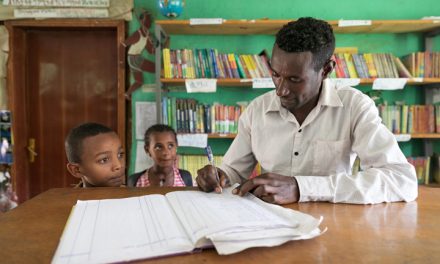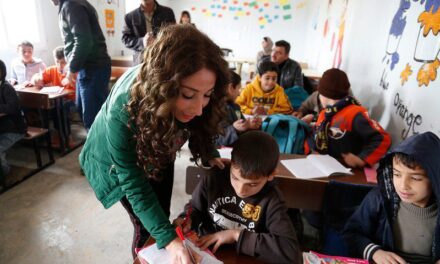This blog was written by Rachel Outhred, Senior Researcher with the Young Lives programme at Oxford University and Director at Oxford MeasureEd, and Alina Lipcan, Senior Education Adviser at the Education Outcomes Fund for Africa and the Middle East. It is the second of a two-part series – the first can be read here. The blog has also been posted on the Education Outcomes Fund website.
During the current COVID-19 global pandemic, those responsible for delivering and receiving education around the world have been forced to fundamentally shift their practice with 91 percent of the world’s student population impacted by school closures.
Almost overnight, COVID-19 has addressed one of the major challenges of EdTech: convincing entire workforces and individuals to shift their professional practice. However, anyone on Twitter will have seen testimonies that university professors and teachers have had varying levels of success delivering in this mode to their, often more technologically adept, students. Sadly, the history of EdTech tells us that poor implementation is not only a major risk, but has plagued EdTech’s success, particularly in developing countries.
Three greatest challenges for EdTech
This blog outlines the three greatest challenges for EdTech: poor implementation, missed opportunities and missing technologies. We argue that large-scale take up is not enough to push EdTech towards a better future.
-

Elsiemae Buckle of Rising Academies records a lesson in Sierra Leone’s capital, Freetown, that will be broadcast on national radio (Courtesy of Rising Academies)
Poor implementation is when a technology is inappropriate, poorly introduced or applied in the wrong context. We have all heard at least one story of the majority of expensive devices being left in school cupboards, when provided at scale. Appropriate implementation needs to consider end users, devices, the purpose of the design solution and the context. For example, we have recently seen examples around the world of promising initiatives where governments have successfully adapted existing technologies to the infrastructural constraints of the context. Examples include the On-Air collaboration with the Ministry of Education in Sierra Leone (content provided by Rising Academies); and radio and online learning in Ghana.
- Missed opportunities happen when technology exists that could improve learning in a given context, but is not used. In these situations, decision makers might not know about the technological solution that could help them or the technology might be prohibitively expensive and/or lack investors. For example, promising solutions to deliver adaptive learning via SMS technology already exist for secondary education and could be adapted for other levels of education (e.g. the Mtabe app). There is evidence also from the health field that structured WhatsApp groups can significantly impact on teacher professional development. Connecting decision-makers with innovators who may not be familiar with how to navigate the multiple layers of customers and end-users within the education system is paramount. Identifying champions of change with sufficient influence to move the industry in a particular direction can minimise fragmentation within the system.
- Missing technologies: Appropriate ICTs may simply not exist for problems in contexts that need it the most. Most funding for new technology is available for wealthier contexts with a clearly articulated demand for new technology. Innovators may have relevant ideas or even a working model but cannot access the resources to demonstrate that they work at scale. To deliver learning, investors and funders need to be able to take calculated risks in supporting these innovators, particularly in a time of crisis and stretched resources. Large scale shifts in the professional practices of teachers and education actors alone is not enough for EdTech to deliver on its promise.
More than just evidence is needed
To address the challenges we describe, we need better decisions and better innovation built on a foundation of better theory, more and better evidence, stronger dialogue, increased capacities and more and better investment in EdTech. Below, we describe each of these necessary components:
Theory. We know that digital technologies – and the ways in which different societies and cultures adopt, adapt, and appropriate them – continue to evolve rapidly, and so too do the theories, concepts, and frameworks that attempt to analyse and understand them. This requires drawing deep knowledge from a variety of academic disciplines to understand phenomena and address real world problems. (We write about this topic in the first of this two-part blog).
More and better evidence. Transparent, trusted, and high-quality evidence of what works, why, and how, and at what cost in different settings, and how to scale it, is desperately needed. This will require cost-effective, rapidly-adaptive, locally-appropriate, and nationally-embedded research processes. Given the urgency of responding to the pandemic, these processes are not always embedded in the COVID-19 EdTech offerings. But to the extent to which the technology supporting learning can also be used to collect even rudimentary data about use and learning, invaluable evidence will be provided about what works and at what cost. Also, online focus groups and phone interviews can push on the boundaries of innovation in research to continue building the EdTech evidence base.
Dialogue. Decision-makers, implementers, entrepreneurs, investors, civil society, national and local policymakers, academics and other researchers, as well as schools, school leaders, teachers, and pupils will need to engage in dialogue to move cost-effective EdTech innovations from ideas to at-scale solutionsA globally-coordinated effort towards multi-disciplinary dialogue on evidence to inform decisions is required, and increased reliance on technology can be catalytic to stimulating the discussion by suppressing physical distance boundaries.
Capacities. Disseminating evidence about what works is not going to be fruitful unless there has been a real effort to co-create it with the key intended audience. Education ministries need to be in the driving seat of articulating what is needed, and partners need to play their role in helping governments assess the quality of the available evidence and open up the political space for evidence-based policy-making.
Finally, more and better investment in EdTech is required to support building theories, evidence, dialogue and capacities; and to support innovators to design and adapt cost-effective solutions. This is the time for traditional education funders to thoughtfully partner with private sector companies and investors (commercial and impact-focused) and share the risks of appropriate innovation.
So, while we scramble to deliver education in the times of COVID-19, let’s not get bogged down in evidence alone. Evidence quality, dialogue between the full set of actors in the EdTech space, capacities to use evidence and more and better investment in EdTech also need our attention.





